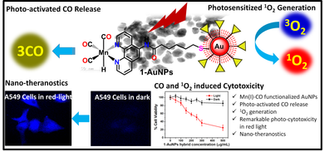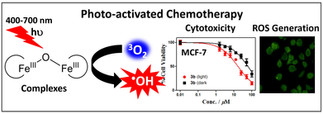Exploring photochemistry of transition metal complexes for photo-activated chemotherapy
- Mithun Roy

- Dec 4, 2016
- 2 min read
Updated: May 26, 2021
Cancer is among the leading causes of mortality worldwide with 8.2 million related deaths and 14 million new cases in 2012 and the projected cancer-related death is estimated to be 13.1 million in 2030. Therefore efforts are needed to find targeted, cost-effective cancer therapeutic modalities. Among the present cancer treatment modalities high recurrence rate associated with surgical resection of tumors, high radiation dose in radiotherapy and systemic side-effects in chemotherapy have limited such treatment modalities in anti-cancer research. Photodynamic therapy (PDT) has emerged as an alternative non-invasive, tumor-ablative treatment modality in which a tumor-localizing photo-sensitizer (PS) for example photofrin® is administered followed by localize illumination of the tumor with the red-light. In this process singlet oxygen (1O2) is oxidizing key cellular macromolecules leading to tumor cell ablation. Hence, PDT ensure significantly higher tumor specificity as the photoexposure to the PS is highly localized only in tumors unlike chemotherapy and radiation therapy. However, PDT has yet to gain clinical acceptance as a first-line oncological intervention due to the lack of an ideal PS free from any systemic side effects. Photo-activated states of transition metal complexes displaying several chemical reactions can be best explored for photo-chemotherapeutic applications. Our present research explore photo-redox chemistry, photo-chemical ligand exchange reactions of the visible-light (PDT window) activated transition metal complexes for light-activated chemotherapeutic applications.
Ref:
Iron(III) Complex-Functionalized Gold Nanocomposite as a Strategic Tool for Targeted Photochemotherapy in Red Light, Inorg. Chem., 2021, 60, 6283–6297.
Photo-physical, theoretical and photo-cytotoxic evaluation of a new class of lanthanide(iii)–curcumin/diketone complexes for PDT application, Dalton Trans., 2020,49, 10786-10798.
Potent anticancer activity of photo-activated oxo-bridged diiron(III) complexes, Eur. J. Med. Chem., 2017, 125, 816-824.
Modulating In Vitro Photodynamic Activities of Copper(II) Complexes, Eur. J. Inorg. Chem., 2018, 2018, 2011-2018.
Nucleus targeting anthraquinone-based copper (II) complexes as the potent PDT agents: Synthesis, photo-physical and theoretical evaluation, Inorg. Chim. Acta, 2020, 500,119208.
Photochemical and photocytotoxic evaluation of new Oxovanadium (IV) complexes in photodynamic application, J. Chem. Sci., 2021, https://doi.org/10.1007/s12039-021-01896-4.









Comments